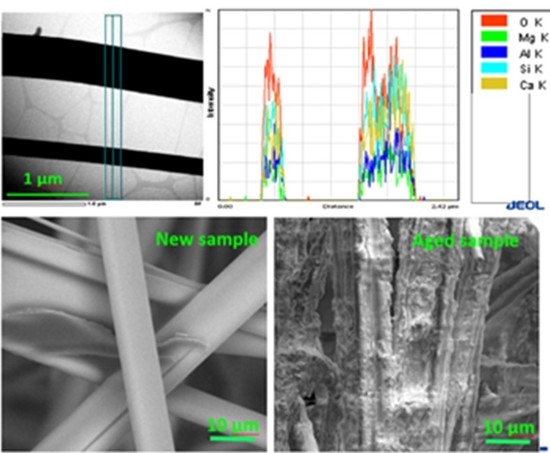The Influences of Moisture on the Mechanical, Morphological and Thermogravimetric Properties of Mineral Wool Made from Basalt Glass Fibers
Abstract
:1. Introduction
2. Materials and Methods
2.1. Materials from Case Study
2.2. Moisture Content and Mechanical Testing
2.3. Morphological and Chemical Composition Characterization
2.4. Thermal Characterization
3. Results and Discussion
3.1. Water Content and Mechanical Performance
3.2. Microscopic Analysis
3.2.1. Scanning Electron Microscopy
3.2.2. SEM Coupled with EDX Detector
3.2.3. STEM Analysis
3.2.4. Thermal Behavior
4. Conclusions
- Degraded insulating materials extracted from the softened roofing area had high moisture content, probably due to the depolymerization of resin.
- Mean compressive strength (σ10, mean) of the extracted degraded samples was 93% lower than the declared value.
- Microanalyses showed the random distribution of basalt fibers with locally melting binder inserts in the form of droplets. The surface morphology of aged samples showed that fibers were surrounded by a non-uniform layer with many cracks and bulges.
- Different chemical composition was detected on the surface of aged samples compared to new ones. Aged samples showed a relative increase in Al and Ca, and we might assume that Al2O3 and CaO deposits were formed on the surface.
- Heterogeneities near the aged fiber surface on a scale of 10 nm showed the formation of a thin ribbed layer on the surface that might indicate ion exchange on the sample surface.
- Combustion tests affected the aged sample to a lesser extent because formaldehyde resin had already degraded to some degree before the analysis was carried out.
Author Contributions
Funding
Acknowledgments
Conflicts of Interest
References
- D’Alessandro, F.; Baldinelli, G.; Bianchi, F.; Sambuco, S.; Rufini, A. Experimental assessment of the water content influence on thermo-acoustic performance of building insulation materials. Constr. Build. Mater. 2018, 158, 264–274. [Google Scholar] [CrossRef]
- Parlato, M.; Porto, S. Organized Framework of Main Possible Applications of Sheep Wool Fibers in Building Components. Sustainability 2020, 12, 761. [Google Scholar] [CrossRef] [Green Version]
- Yliniemi, J.; Kinnunen, P.; Karinkanta, P.; Illikainen, M. Utilization of mineral wools as alkali-activated material precursor. Materials 2016, 9, 312. [Google Scholar] [CrossRef] [PubMed]
- Wei, B.; Cao, H.; Song, S. Tensile behavior contrast of basalt and glass fibers after chemical treatment. Mater. Des. 2010, 31, 4244–4250. [Google Scholar] [CrossRef]
- Vrána, T.; Björk, F. Frost formation and condensation in stone–wool insulations. Constr. Build. Mater. 2009, 23, 1775–1787. [Google Scholar] [CrossRef]
- Lund, M.D.; Yue, Y.-Z. Influences of chemical aging on the surface morphology and crystallization behavior of basaltic glass fibers. J. Non-Cryst. Solids 2008, 354, 1151–1154. [Google Scholar] [CrossRef]
- Vrána, T.; Gudmundsson, K. Comparison of fibrous insulations–Cellulose and stone wool in terms of moisture properties resulting from condensation and ice formation. Constr. Build. Mater. 2010, 24, 1151–1157. [Google Scholar] [CrossRef]
- Achchaq, F.; Djellab, K.; Beji, H. Hydric, morphological and thermo-physical characterization of glass wools: From macroscopic to microscopic approach. Constr. Build. Mater. 2009, 23, 3214–3219. [Google Scholar] [CrossRef]
- Jiřičková, M.; Černý, R. Effect of hydrophilic admixtures on moisture and heat transport and storage parameters of mineral wool. Constr. Build. Mater. 2006, 20, 425–434. [Google Scholar] [CrossRef]
- Jerman, M.; Černý, R. Effect of moisture content on heat and moisture transport and storage properties of thermal insulation materials. Energy Build. 2012, 53, 39–46. [Google Scholar] [CrossRef]
- Rasmussen, T.V.; Nicolajsen, A. Assessment of the performance of organic and mineral-based insulation products used in exterior walls and attics in dwellings. Build. Environ. 2007, 42, 829–839. [Google Scholar] [CrossRef]
- Toman, J.; Vimmrová, A.; Černý, R. Long-term on-site assessment of hygrothermal performance of interior thermal insulation system without water vapour barrier. Energy Build. 2009, 41, 51–55. [Google Scholar] [CrossRef]
- Gutiérrez-Orrego, D.A.; Garcia-Aristizabal, E.F.; Gomez-Botero, M.A. Mechanical and physical properties of soil-cement blocks reinforced with mineral wool and sisal fiber. J. Mater. Civ. Eng. 2017, 29, 04016225. [Google Scholar] [CrossRef]
- Väntsi, O.; Kärki, T. Utilization of recycled mineral wool as filler in wood–polypropylene composites. Constr. Build. Mater. 2014, 55, 220–226. [Google Scholar] [CrossRef]
- Moretti, E.; Belloni, E.; Agosti, F. Innovative mineral fiber insulation panels for buildings: Thermal and acoustic characterization. Appl. Energy 2016, 169, 421–432. [Google Scholar] [CrossRef]
- Nguyen, D.M.; Grillet, A.-C.; Diep, T.M.H.; Ha Thuc, C.N.; Woloszyn, M. Hygrothermal properties of bio-insulation building materials based on bamboo fibers and bio-glues. Constr. Build. Mater. 2017, 155, 852–866. [Google Scholar] [CrossRef]
- Jelušič, P.; Kravanja, S. Flexural analysis of laminated solid wood beams with different shear connections. Constr. Build. Mater. 2018, 174, 456–465. [Google Scholar] [CrossRef]
- Yu, Y.; Xu, P.; Chang, M.; Chang, J. Aging Properties of Phenol-Formaldehyde Resin Modified by Bio-Oil Using UV Weathering. Polymers 2018, 10, 1183. [Google Scholar] [CrossRef] [Green Version]
- Öztürk, S. The effect of fibre content on the mechanical properties of hemp and basalt fibre reinforced phenol formaldehyde composites. J. Mater. Sci. 2005, 40, 4585–4592. [Google Scholar] [CrossRef]
- Ayub, T.; Shafiq, N.; Khan, S.U. Compressive stress-strain behavior of HSFRC reinforced with basalt fibers. J. Mater. Civ. Eng. 2016, 28, 06015014. [Google Scholar] [CrossRef]
- Lehuede, P.; De Meringo, A. SEM-EDS analysis of glass fibers corroded in physiological solutions by dynamic tests with variable flow rates. Environ. Health Perspect. 1994, 102, 73–75. [Google Scholar] [CrossRef] [PubMed] [Green Version]
- Zhukov, A.; Bobrova, E.; Smirnova, T. Evaluation of durability of mineral wool products. Proc. Adv. Mater. Res. 2015, 1077, 109–112. [Google Scholar] [CrossRef]
- Simon, T.K.; Mlinárik, L.; Vargha, V. Effect of water vapor on the compressive strength of a mineral wool insulation board. J. Build. Phys. 2015, 39, 285–294. [Google Scholar] [CrossRef]
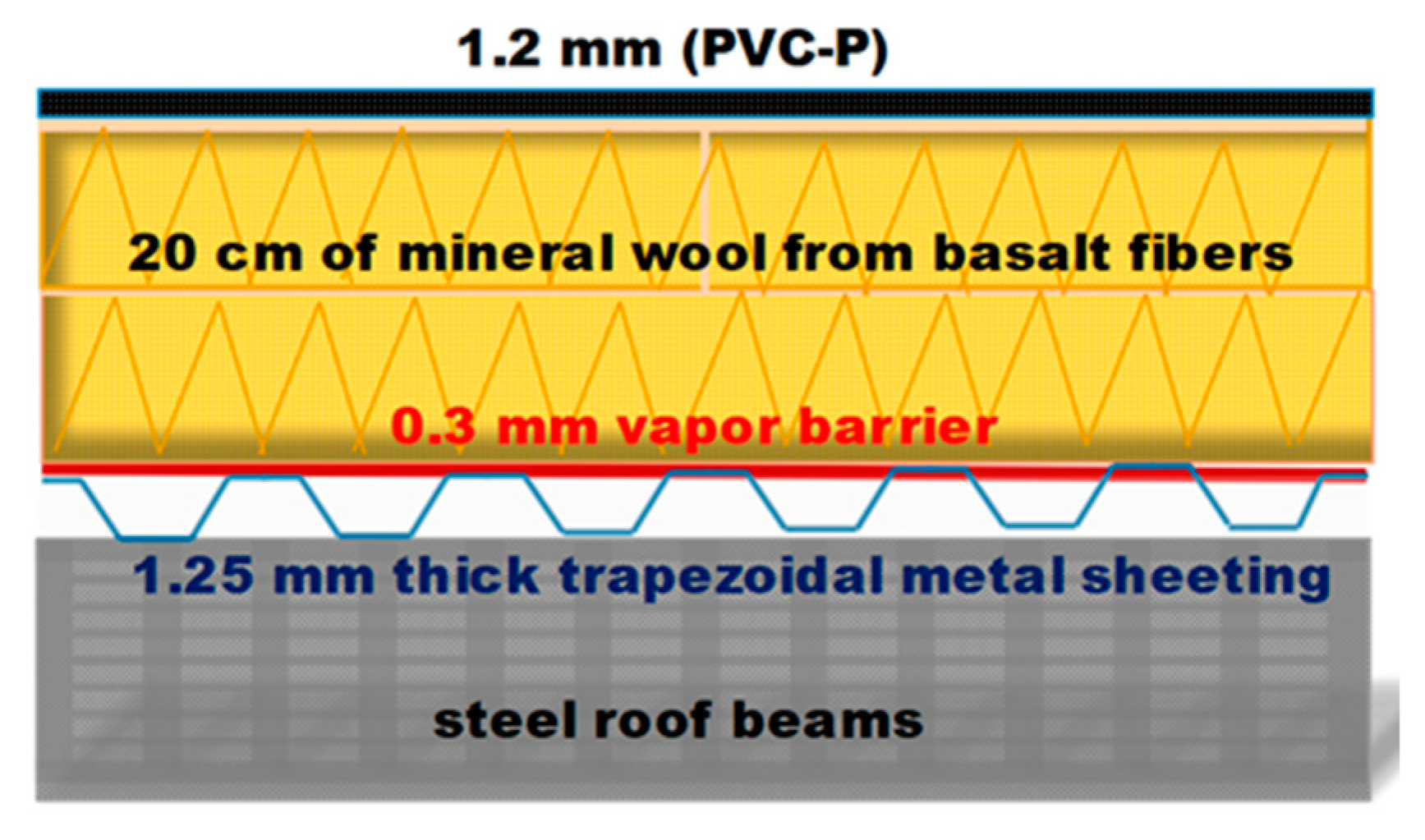
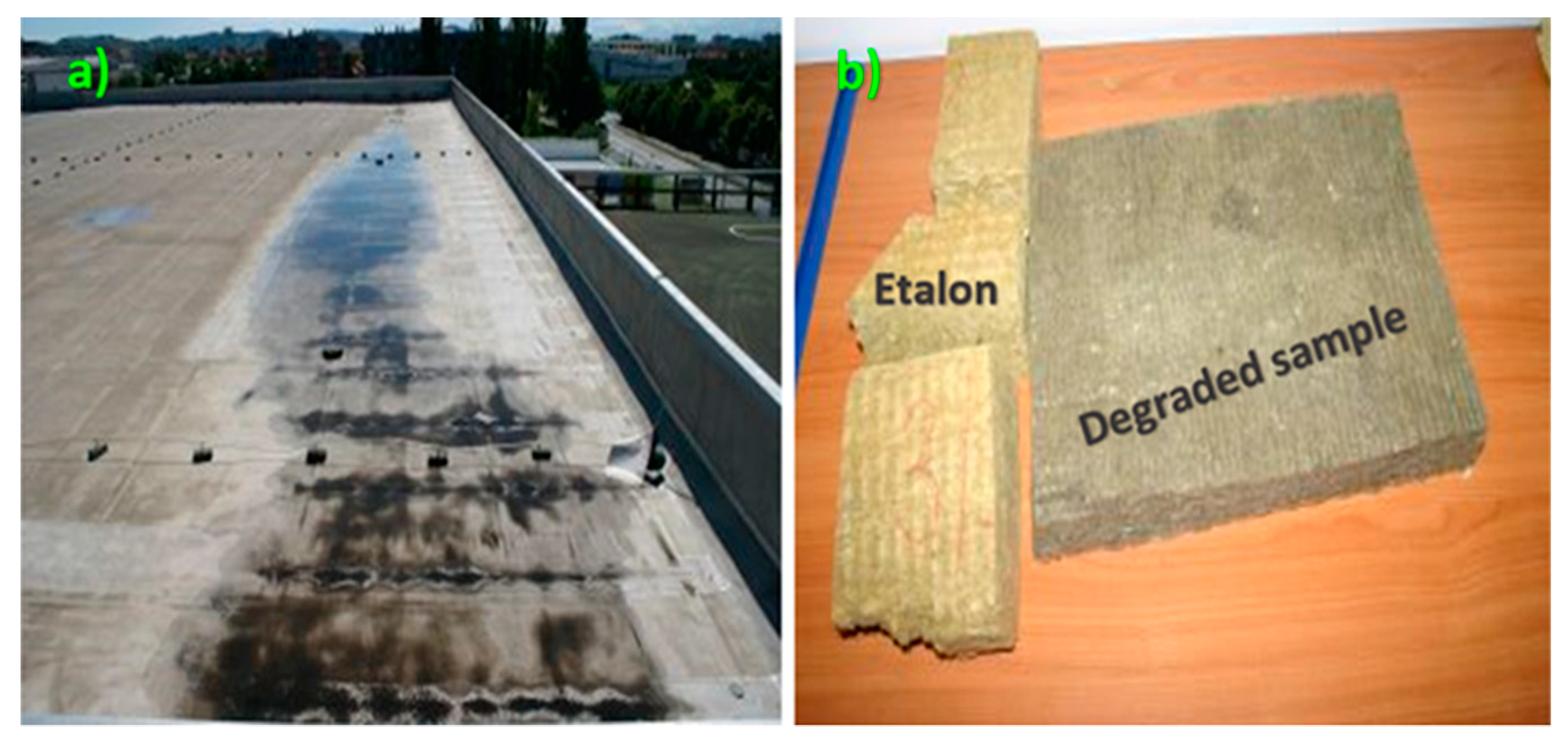
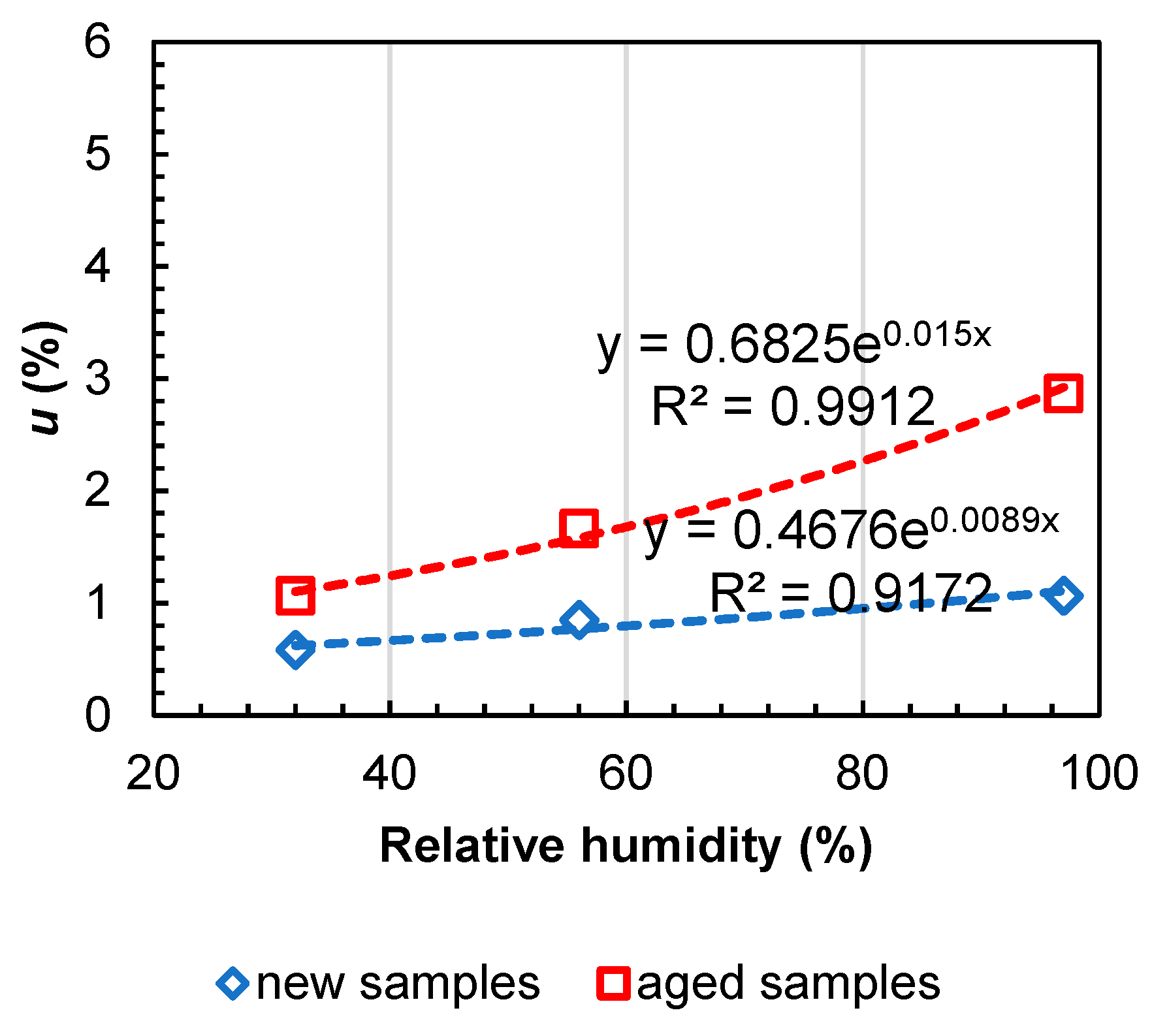
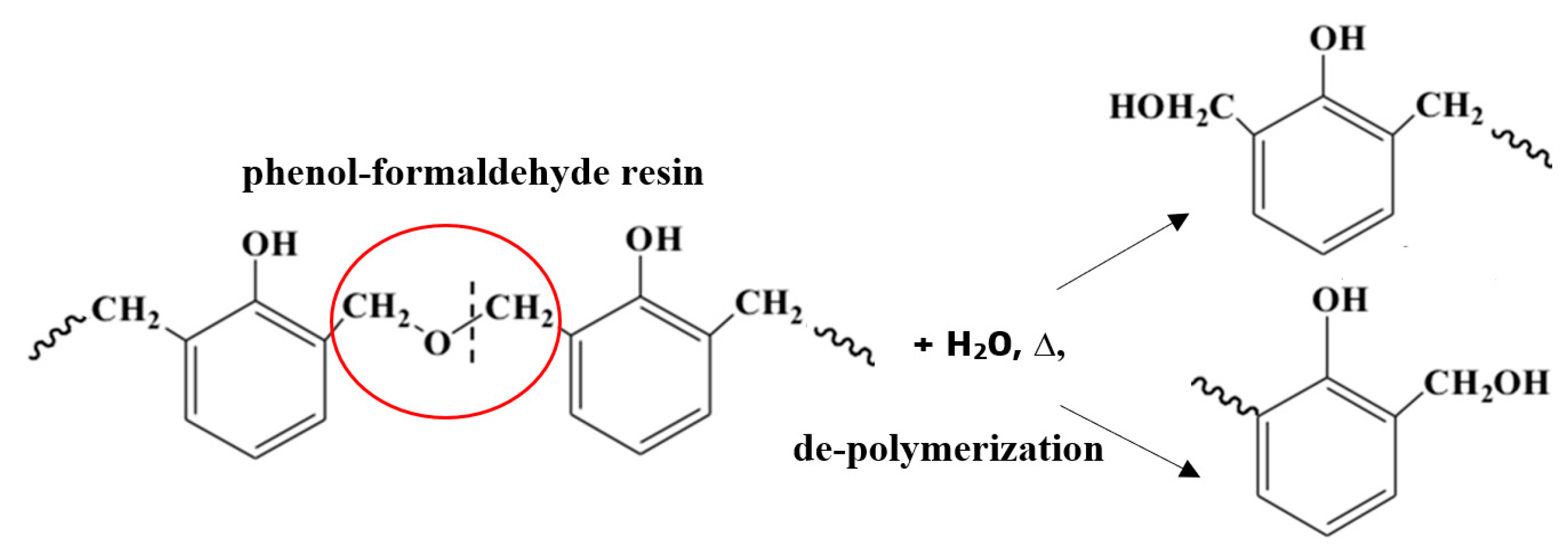
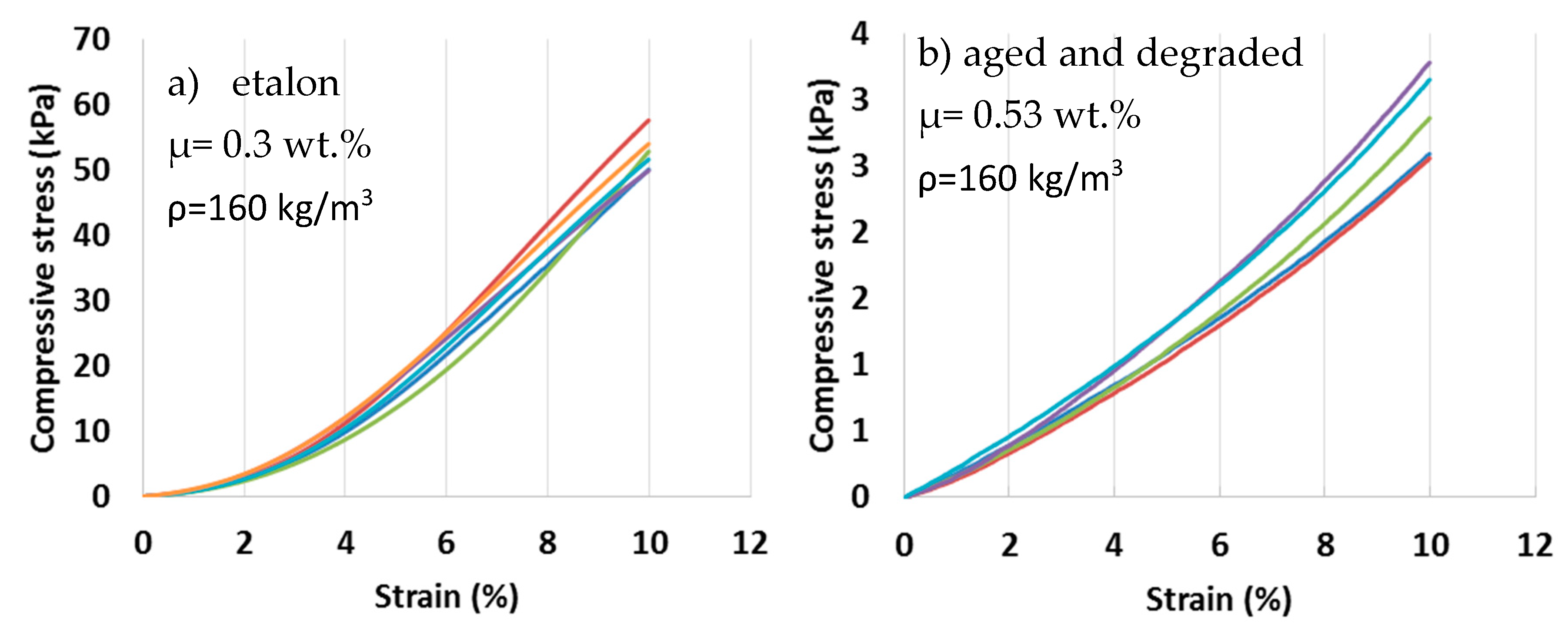
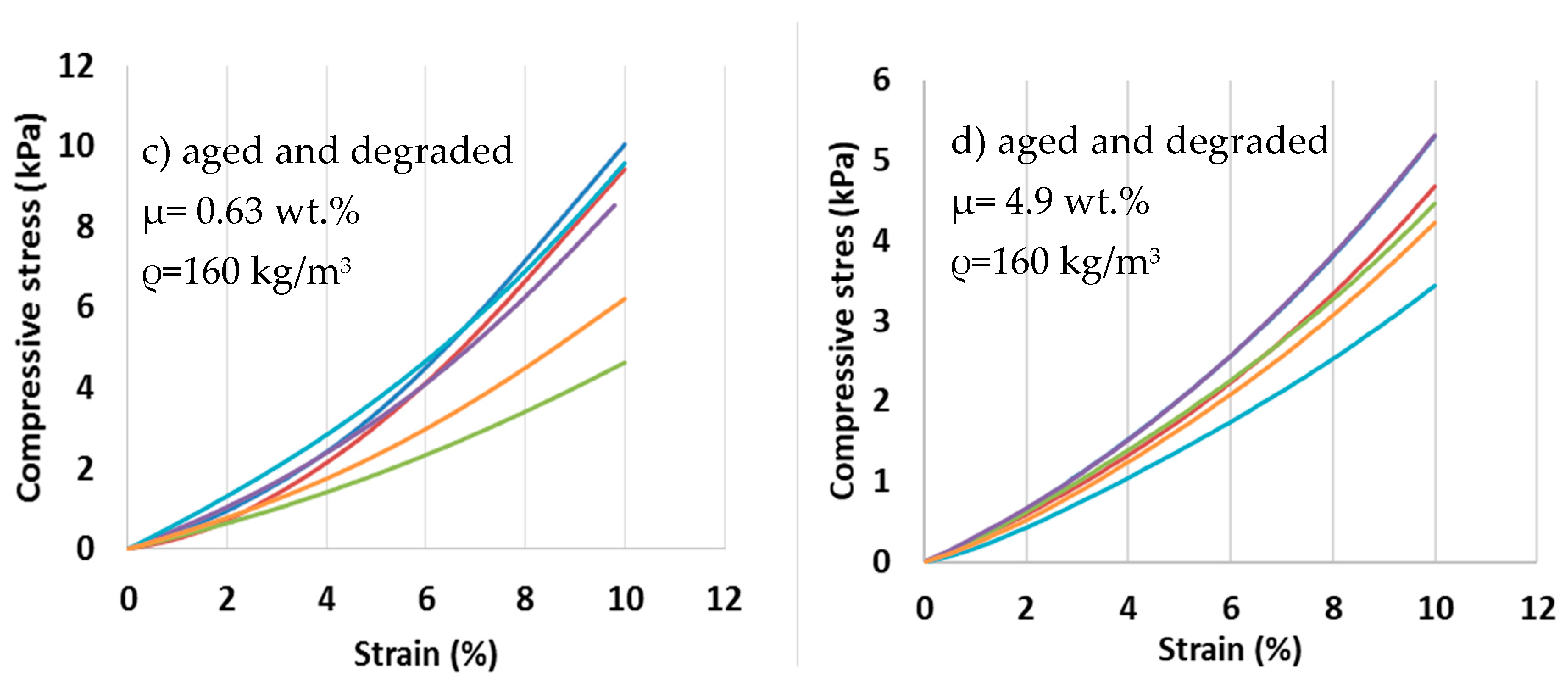
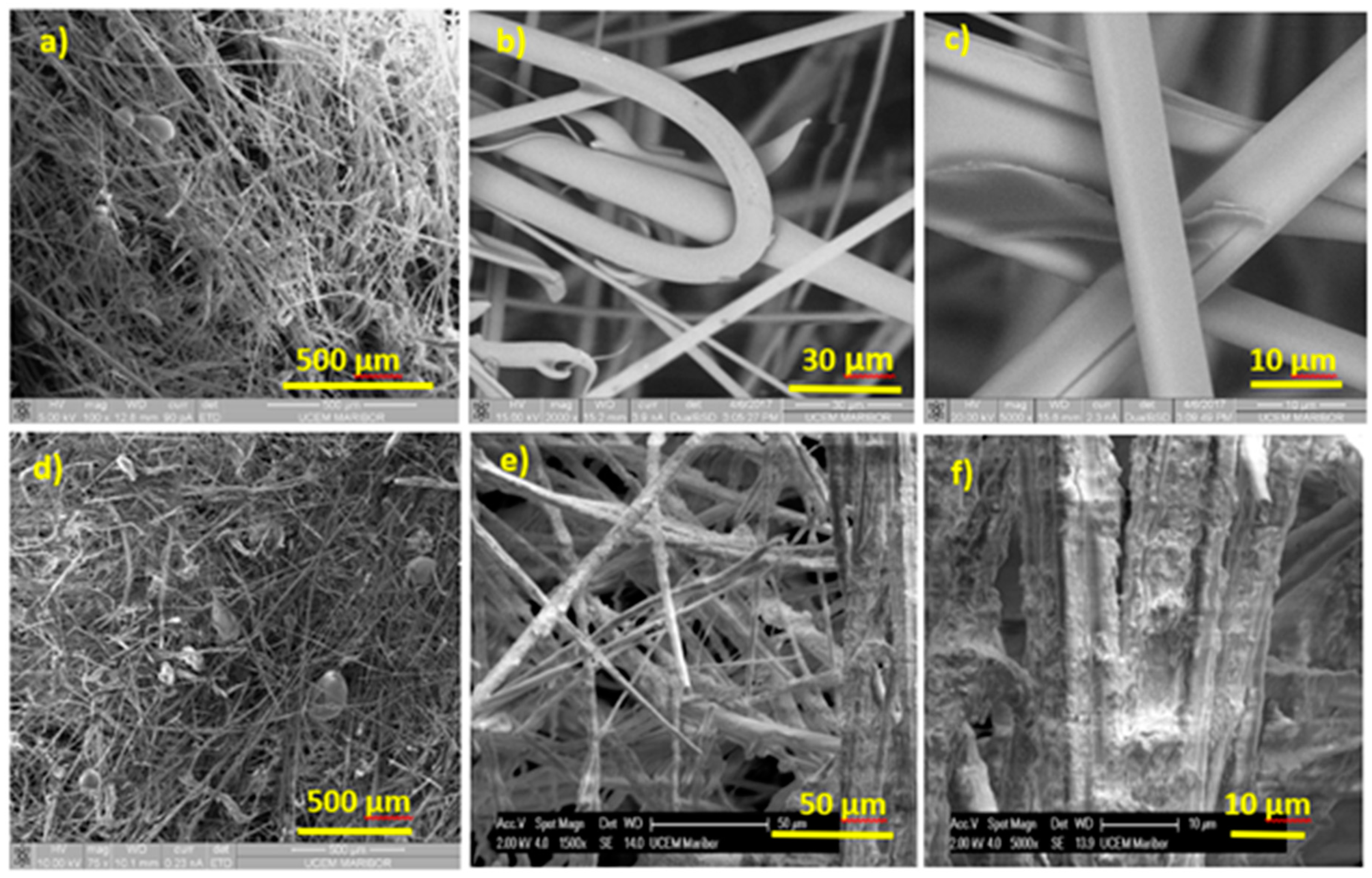
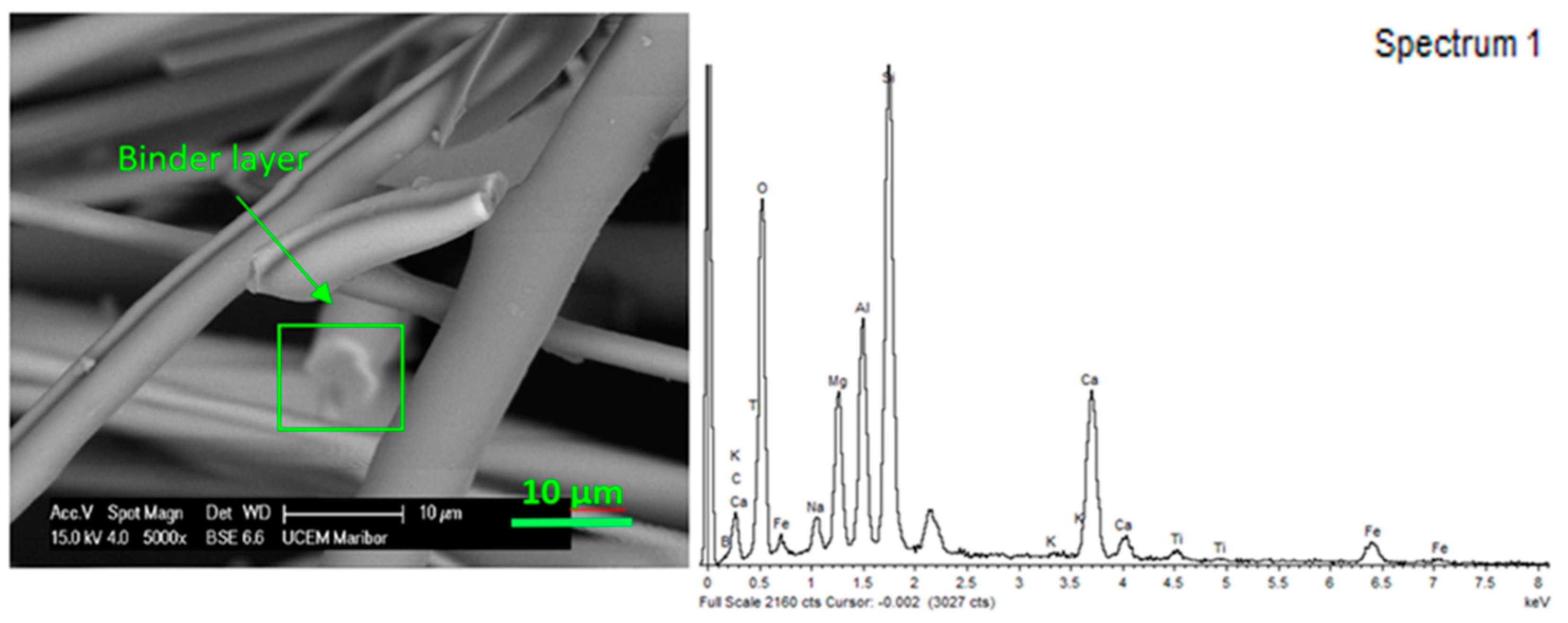
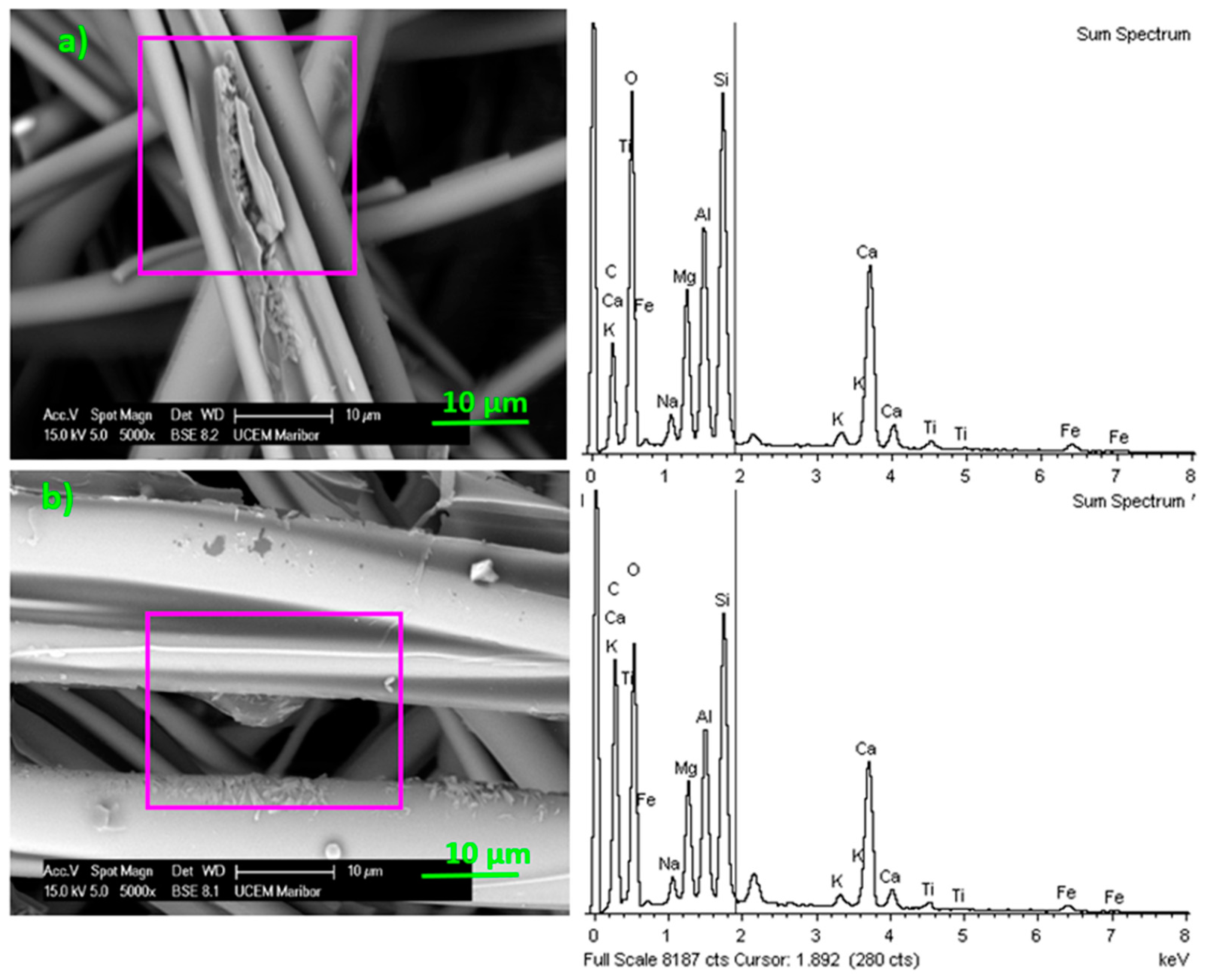
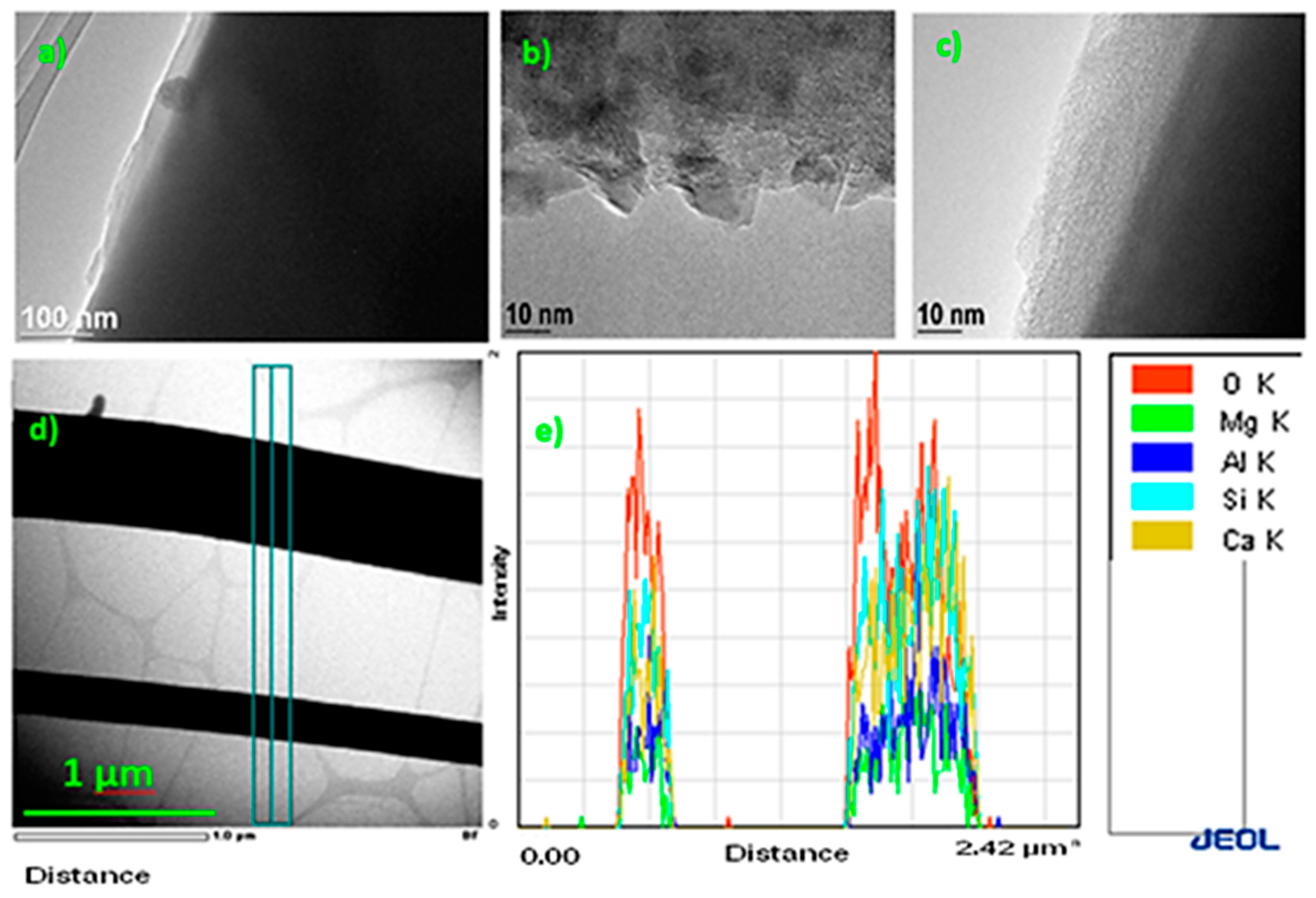
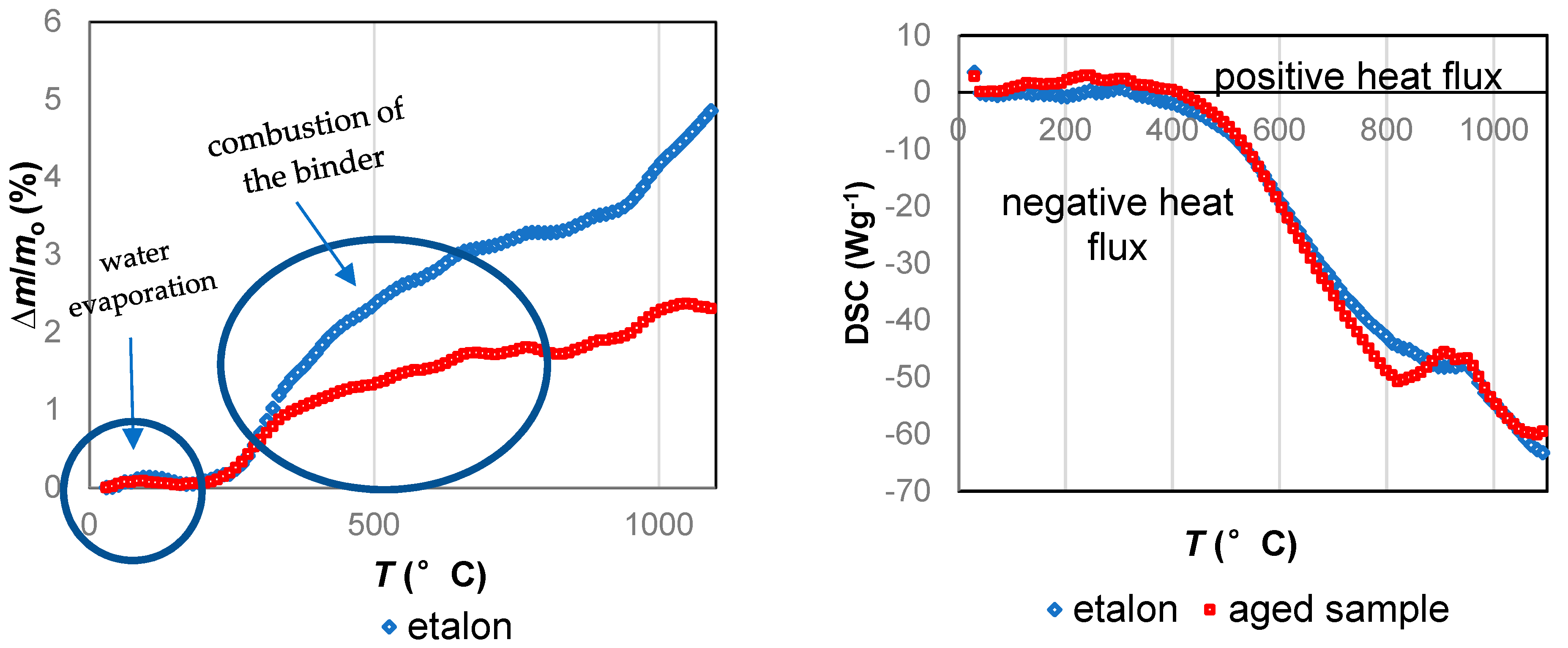
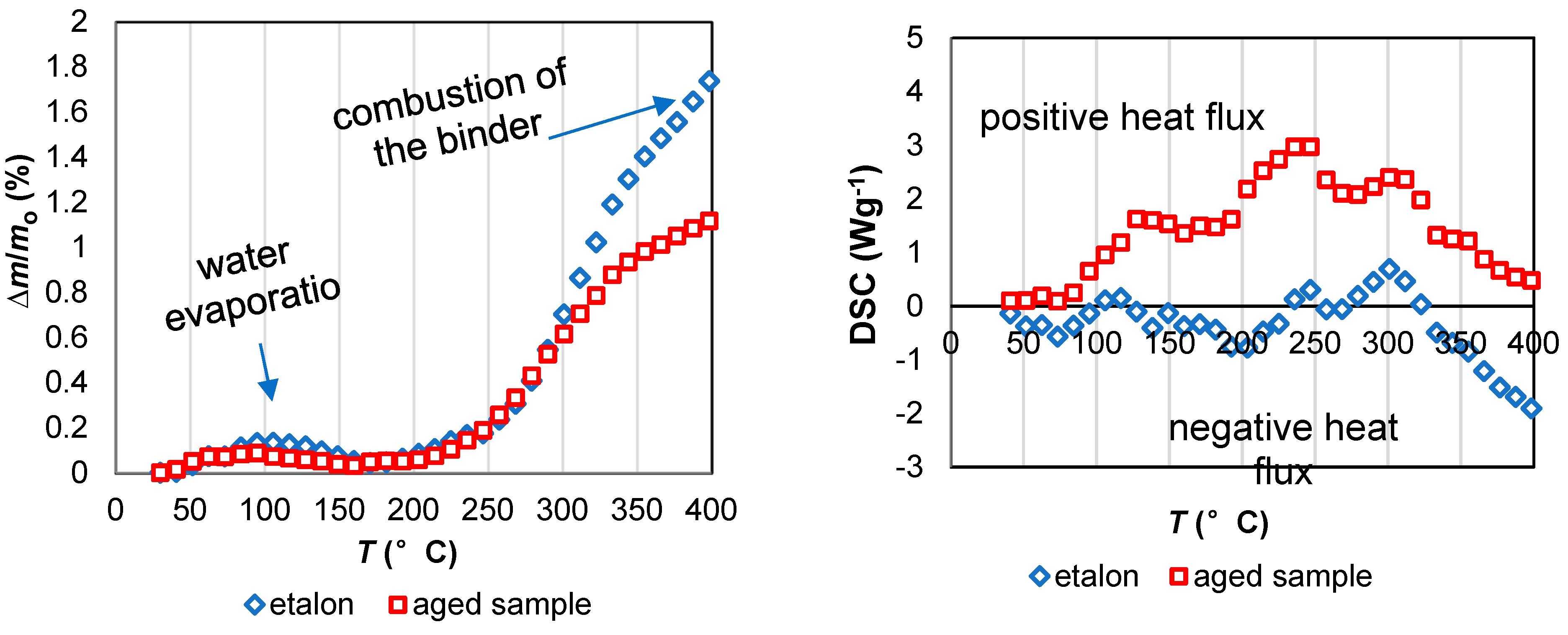
| Sample | umin (wt.%) | umean (wt.%) | umax (wt.%) | σ10, min (kPa) | σ10, mean (kPa) | σ10, max (kPa) | σ10, dec (kPa) |
|---|---|---|---|---|---|---|---|
| Mineral wool | 0.53 | 0.63 | 4.90 | 2.18 | 5.21 | 10.20 | 70 |
| Spectrum | B | Na | Mg | Al | Si | K | Ca | Ti | Fe |
|---|---|---|---|---|---|---|---|---|---|
| Etalon | 7.43 | 0.96 | 3.26 | 4.21 | 9.72 | 0.09 | 6.43 | 0.35 | 2.45 |
| Cracks | 4.22 | 1.50 | 4.60 | 5.96 | 12.08 | 0.89 | 14.11 | 1.04 | 2.78 |
| Bulges | 4.16 | 0.92 | 3.90 | 5.03 | 10.24 | 0.57 | 10.33 | 0.77 | 1.94 |
| Ratio | B/Si | Na/Si | Mg/Si | Al/Si | K/Si | Ca/Si | Ti/Si | Fe/Si |
|---|---|---|---|---|---|---|---|---|
| Etalon | 0.76 | 0.10 | 0.34 | 0.43 | 0.01 | 0.66 | 0.04 | 0.25 |
| Cracks | 0.35 | 0.12 | 0.38 | 0.49 | 0.07 | 1.17 | 0.09 | 0.23 |
| Bulges | 0.41 | 0.09 | 0.38 | 0.49 | 0.06 | 1.01 | 0.08 | 0.19 |
© 2020 by the authors. Licensee MDPI, Basel, Switzerland. This article is an open access article distributed under the terms and conditions of the Creative Commons Attribution (CC BY) license (http://creativecommons.org/licenses/by/4.0/).
Share and Cite
Ivanič, A.; Kravanja, G.; Kidess, W.; Rudolf, R.; Lubej, S. The Influences of Moisture on the Mechanical, Morphological and Thermogravimetric Properties of Mineral Wool Made from Basalt Glass Fibers. Materials 2020, 13, 2392. https://doi.org/10.3390/ma13102392
Ivanič A, Kravanja G, Kidess W, Rudolf R, Lubej S. The Influences of Moisture on the Mechanical, Morphological and Thermogravimetric Properties of Mineral Wool Made from Basalt Glass Fibers. Materials. 2020; 13(10):2392. https://doi.org/10.3390/ma13102392
Chicago/Turabian StyleIvanič, Andrej, Gregor Kravanja, Wadie Kidess, Rebeka Rudolf, and Samo Lubej. 2020. "The Influences of Moisture on the Mechanical, Morphological and Thermogravimetric Properties of Mineral Wool Made from Basalt Glass Fibers" Materials 13, no. 10: 2392. https://doi.org/10.3390/ma13102392
APA StyleIvanič, A., Kravanja, G., Kidess, W., Rudolf, R., & Lubej, S. (2020). The Influences of Moisture on the Mechanical, Morphological and Thermogravimetric Properties of Mineral Wool Made from Basalt Glass Fibers. Materials, 13(10), 2392. https://doi.org/10.3390/ma13102392





